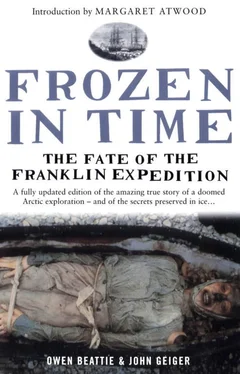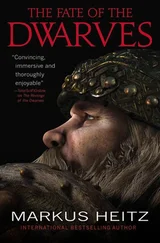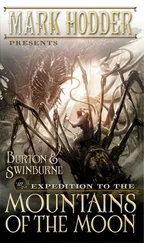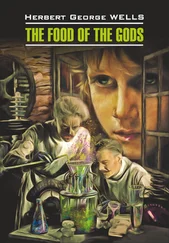The first part of the examination was a meticulous search for external signs of the cause or causes of death (wounds, markings, disease) or of medical treatment (signs of medicinal bleeding). None was found except for the deep and discoloured marks on the elbows, hands and ankles made by the cotton bindings. Then Beattie conducted a standard autopsy. Tissue, organ, bone, fingernail and hair samples were taken for analysis by Roger Amy at his laboratory at the University of Alberta.
The autopsy took more than four hours to complete. Beattie and Carlson wore surgical aprons, their hands double gloved with rubber surgical gloves. The procedure involved making a Y-shaped incision in the chest and abdomen, retracting the skin and musculature, the temporary removal of the front portion of the rib cage and exposure of the thoracic and abdominal organs. Yet when the autopsy began, all internal structures were completely frozen. It was necessary to thaw each organ with water before samples could be collected. Using a scalpel, .3–7 ounces (10–20 grams) of tissue were then collected from each organ. Carlson and Damkjar prepared and marked the sample containers with identification information and numbers. A preservative was poured in them and Beattie dropped each collected sample in the appropriate container, which was then sealed. Damkjar also took pictures of the various stages of the autopsy while Kowal took notes dictated to him by Beattie. One of the most difficult aspects of the whole procedure was keeping their hands warm, and one bucket of hot water was kept nearby so that Beattie and Carlson could immerse their hands in it.
From the beginning, Beattie could see features that could be of medical importance. The lungs, when exposed, appeared completely blackened and were attached abnormally in a number of locations to the chest wall by a series of adhesions (scar tissue). Torrington’s heart also appeared abnormal. No food could be found in the stomach or bowel.
Torrington’s right thumbnail was collected, as were samples of his hair, rib bone and radius bone. These would be subjected to various forms of analysis in later months in an attempt to construct a diary of his health during the time he spent on the expedition prior to his death, as well as a short period of time prior to the expedition.
A difficult but necessary procedure during an autopsy is the exposure of the brain. With a surgical hand saw, and with assistance from Carlson and Damkjar, Beattie removed the skull cap and collected samples of brain tissue and made observations of the brain anatomy. All of the samples collected and observations made would be pieced together later after Amy’s analysis of the data and microscopic evidence from the samples.
During the autopsy, Beattie saw that, even though preservation of the body was excellent, post-mortem degenerative changes in the structure of the tissues had taken place. Later, Amy would confirm that the microscopic details showed that virtually all cellular structures were badly or completely damaged. The brain had also shrunk, as had some of the other organs, to about two-thirds’ normal size, and had completely autolyzed (the cells had been destroyed by their own enzymes). Beattie would later be approached a number of times by people with the idea that perhaps one day in the future, Torrington could have been revived by some elixir or as yet unimagined technology, but the evidence of massive cellular damage found in every organ precluded this possibility.
Throughout the autopsy, Beattie kept Torrington’s face covered; somehow, this gave the reassurance that his privacy was maintained, illustrating how strongly the face is perceived as the window of the soul and the reflection of our identity.
After the autopsy, Torrington was re-dressed, lifted back into his grave and into the coffin. After carefully positioning the body, the lid was then replaced. Water would soon begin to fill the grave again and freeze, ensuring Torrington’s lasting preservation. Ruszala placed a note in the grave, giving the names of the seven researchers and a description of their feelings and purpose at the site. It was a private offering to John Torrington that, along with his body, would quite likely outlast all of the team’s own physical remains after their deaths. The group then quietly gathered together at Ruszala’s suggestion, for silent prayers and some individual thoughts, before John Torrington was again assigned to the frozen depths, maybe this time forever. For these moments, Beattie contemplated Torrington’s life and the events of late 1845 and early 1846, then the events of his own life in the summer of 1984, and how the years separating the two had somehow vanished.
After filling in the grave, Beattie stopped to peer down the beach towards Erebus Bay. It was almost possible to see the two ships held in the ice just offshore, Franklin’s men moving ghostlike in small groups on the ice and across the island. The crews would have paused for John Torrington on those bitter January days of 1846, but none could have guessed what horror his death foretold. Their adventure was young and the Northwest Passage, which had long haunted men, beckoned somewhere across the icy waters to the west.
The arctic summer of 1984 was nearing an end. Although the weather had been generally good (except for the occasional light dusting of snow), the warmth of the summer sun was lost towards the close of August and the nights had turned cold. As each day brought winter closer, nightfall gradually crept into the twenty-four-hour light of the Arctic summer, and a generator had to be used to power a photoflood lamp inside the cook tent in the evenings.
The weather became so unpredictable that, if the team had radioed for an airplane from Resolute to come for them, the half-hour required to fly that distance could have seen a complete change in weather. A simple change in wind direction or a quickly dropping cloud ceiling would also have made a landing on Beechey Island impossible.
Beattie had originally hoped to uncover all three of the Franklin expedition graves on the island that summer, but, worried about the weather and drained by the experience of exhuming John Torrington, his thoughts turned instead towards the laboratory work that awaited him in Edmonton. Three days had been spent on Torrington’s final exhumation and autopsy and the scientific team was exhausted, physically and emotionally. Beattie wanted to pack it in for the season, as did the others. Just one radio call to the Polar Shelf and they could be away from the island. But something had bothered Beattie and the others about the appearance of Hartnell’s grave. Before completing the autopsy on John Torrington, Walt Kowal had begun to dig into the permafrost covering John Hartnell.
A close inspection of the graves of John Hartnell and William Braine soon revealed that their construction by the crew of the Erebus had been very similar, if not identical. But they were no longer so: it was clear that Hartnell’s grave had been disturbed at some point in the 138 years since his death. The large limestone slabs, once part of a grave structure like Braine’s, which has an almost crypt-like appearance, had been simply piled on top of the burial place, as if they had been lifted away and later hastily replaced. Inspecting the surface of the grave and looking closely into the nooks and pockets produced by the large rocks, the researchers found small fragments of wood and some tiny scraps of blue material similar to that which covered Torrington’s coffin. Beattie had no idea when the grave had been disturbed. The team discussed the situation, as well as the difficulty of completing an autopsy on Hartnell within the time remaining. If there had been one or more previous openings of the grave, they would have to take great care in gathering evidence—and the time required for this could be considerable. Beattie decided to look for clues that might explain the history of the damage and determine the state of preservation, but to conduct the autopsy another year.
Читать дальше










